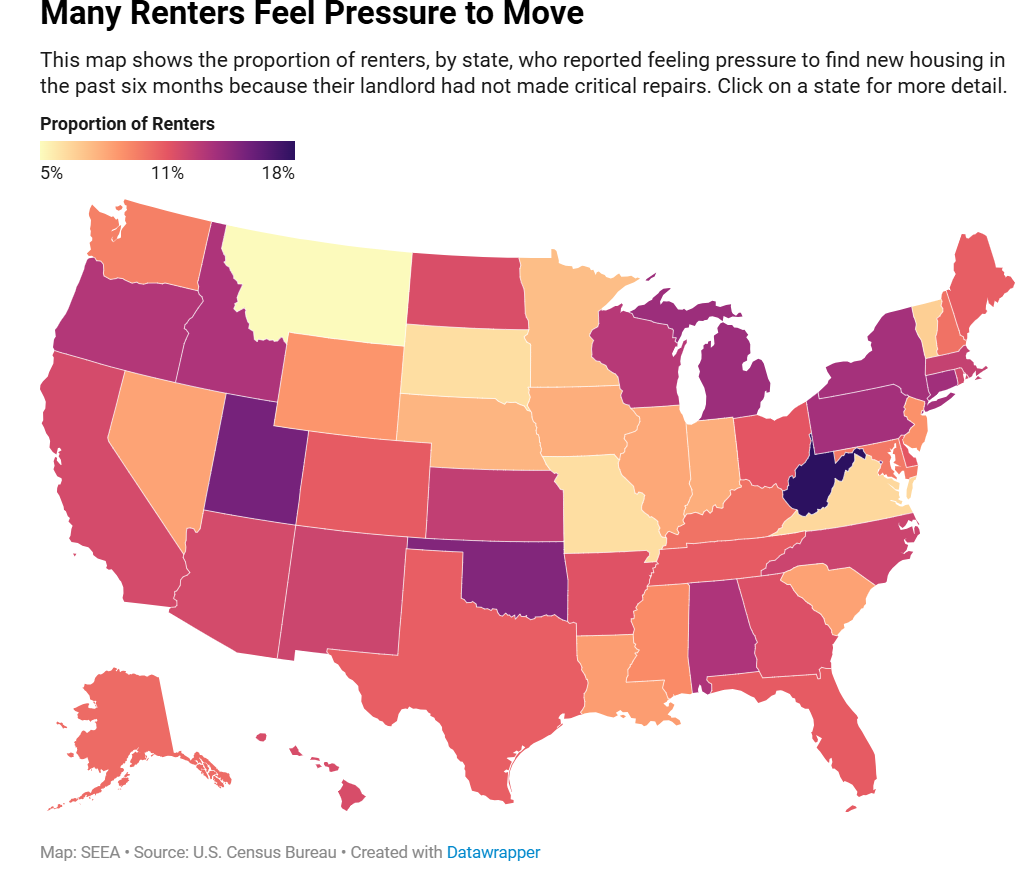October Map of the Month

By William D. Bryan, Ph.D.
On July 1, 2024, Georgia’s Safe at Home Act went into effect. Passed earlier this year, the law establishes that for any lease signed after July 1 Georgia landlords have a “duty of habitability” and must ensure that their rental unit is “fit for human habitation.” This includes maintaining a safe and healthy property and addressing tenants’ maintenance requests in a timely manner, and it gives tenants legal recourse if these conditions are not met.
The Safe at Home Act is a critical step forward, but significant housing quality challenges remain for renters throughout Georgia and the South. A 2022 investigatory series by The Atlanta Journal Constitution underscored that thousands of renters in metro Atlanta face severe housing quality shortfalls and have little bargaining power, particularly with absentee landlords. Deferred maintenance has led to mold, pest infestations, and thermal discomfort that exacerbates health issues like asthma and can be a financial drain for tenants.
While Georgia’s new law provides a pathway to address deferred maintenance, millions of renters in the Southeast still struggle to get their landlords to make critical repairs. Deferred maintenance not only contributes to health struggles, but also undermines housing and community stability by forcing renters to search for better housing. In this way, deferred maintenance can force “involuntary moves” or displacement. While tenants may choose to leave poor housing conditions, this only underscores the lack of formal options for many tenants trying to get maintenance needs and other issues addressed.
This month’s map uses data from the U.S. Census Bureau’s Household Pulse Survey, administered nationally in August and September of 2024, to show the proportion of renters in each state who reported feeling pressure to move in the past six months because of unresolved repair issues with their housing.
The data make it clear that a significant number of renters face housing quality pressures that contribute to housing instability. More than half (52%) of all renters in the United States have felt pressure to move in the last six months, with 11% attributing this to a lack of critical repairs. Other factors forcing tenants to consider a move include increases in rent (19%), a missed rent payment (4%), threats of eviction from a landlord (3%), living in an unsafe neighborhood (5%), or because a landlord has changed the locks or removed tenants’ possessions from a unit (0.2%). Nationally, these issues have an outsized impact on low- and moderate-income renters as well as Hispanic renters, who are most likely to feel pressure to move due to housing conditions.
More than 9 million renters in the South report feeling pressure to move, with nearly 2 million households in the region struggling with deferred maintenance. Even in Virginia, which is generally below the national average, 41% of renters have felt pressure to move in the last six months, driven primarily by sharp increases in rents. In West Virginia, 53% of renters have felt pressure to move and nearly 18% attribute this to unresolved repairs to their housing – the highest rate in the entire nation.
Housing quality and energy efficiency are closely linked, and energy efficiency programs can provide a key source of funding to address deferred maintenance and health issues. Although the “split incentive” between renters and owners makes it difficult for renters to access energy efficiency, there are proven models that can ensure renters are able to access the benefits of energy efficiency and clean energy and to address housing quality shortfalls. Tariffed on bill programs provide capital for home upgrades with repayments provided by the energy savings from upgrades performed. Because these programs are tied to the electric meter, not to an individual, they are available for renters or owners. Atlanta Housing is working with the Solar and Energy Loan Fund (SELF) to provide unsecured loans up to $25,000 to eligible landlords for energy efficiency and clean energy upgrades, paired with a rent boost up to $175 per month to offset loan payments. SEEA’s Room to Breathe program – a partnership with the Atlanta Volunteer Lawyers’ Foundation (AVLF) and SK Collaborative – also provides a model for innovative partnerships that can support tenants in addressing deferred maintenance and securing healthy housing.
Each of these provides key opportunities for leveraging energy efficiency funding to support the millions of renters in the South who struggle with housing insecurity by addressing deferred maintenance. But housing instability is multifaceted, and to address it at scale resources for tenants and landlords must be combined with robust tenant protections.

